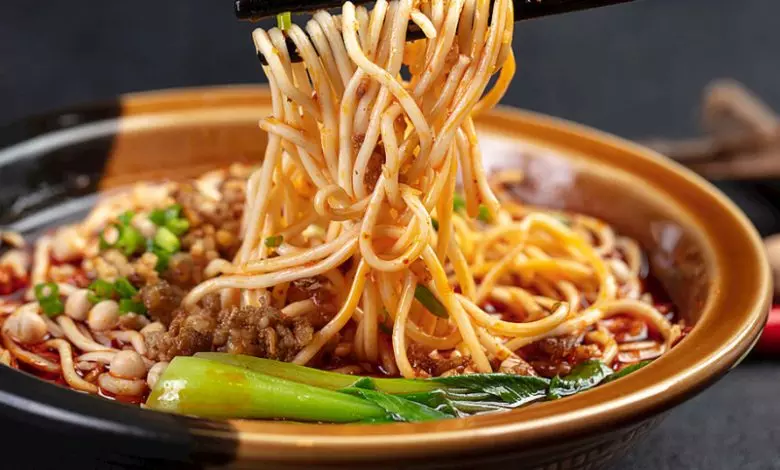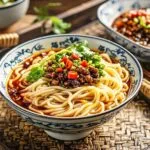Dan Dan Noodles, a beloved dish from the Sichuan province of China, have become globally popular due to their unique flavor profile, which blends intense spiciness, aromatic oils, and satisfying textures. Known in Chinese as Dàndàn Miàn (担担面), these iconic noodles embody the flavors of Sichuan cuisine, famous for its bold use of chili and Sichuan peppercorns. This traditional dish offers a savory, spicy experience, combining minced pork, chili oil, and wheat noodles for a deeply satisfying meal.
Contents:
The Story Behind the Name “Dan Dan Noodles”
The name “Dan Dan Noodles” originates from the traditional way street vendors once carried and sold this dish in Sichuan. The word “Dan Dan” (担担) refers to a carrying pole, which sellers would balance across their shoulders. On one end, they hung a basket of freshly prepared noodles, and on the other, a pot filled with sauce and toppings. This practical setup allowed vendors to serve these noodles on the go, and this street food legacy remains part of the dish’s identity today.
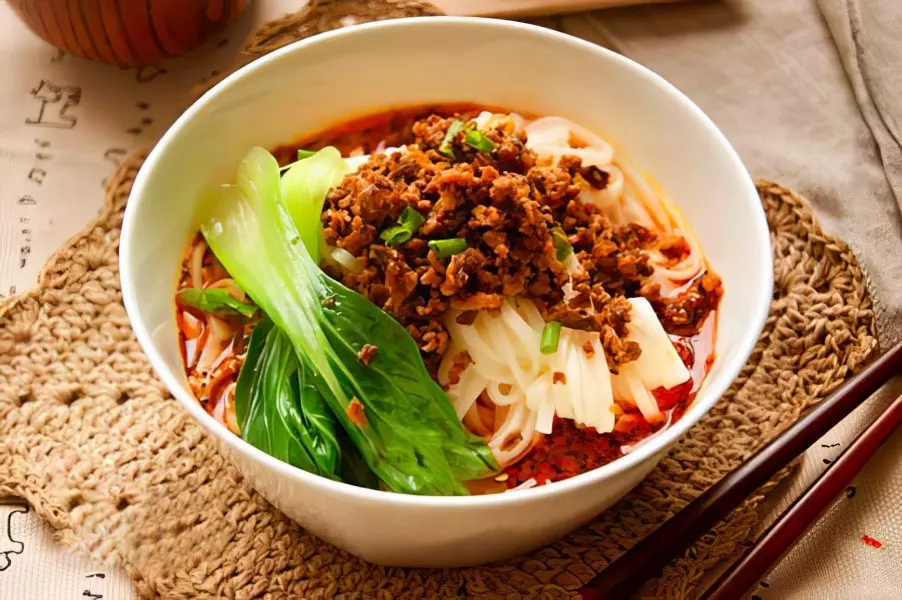
Traditional Dan Dan Noodles: Soup or Dry?
While many people outside of China are familiar with a soupy version of this dish, that variation actually originates from Hong Kong and other regions that adapted it for local palates. In Sichuan, where the dish was born, the traditional version is typically dry or served with only a minimal amount of broth. This “dry” style allows the intense flavors of the sauce to coat each noodle perfectly, creating a concentrated and satisfying bite in every mouthful.
Key Ingredients That Make Dan Dan Noodles Unique
The heart of any authentic Dan Dan Noodles recipe is its spicy, umami-rich sauce. This sauce combines chili oil, soy sauce, Sichuan peppercorns, garlic, ginger, and fermented black beans (douchi) to create a signature blend of spiciness, saltiness, and aromatic depth. The Sichuan peppercorns are particularly essential as they provide the signature “numbing” sensation, or “má” (麻), which, when combined with the spiciness of the chili oil, results in the famous “málà” (麻辣) flavor—an addictive combination of numbing and heat.
Along with the sauce, this iconic Sichuan noodle dish features minced pork cooked with garlic, ginger, and fermented black beans. The savory minced pork balances the intense spice and adds a rich, hearty element to the meal. This combination of chili heat, numbing peppercorns, and savory pork is what gives the dish its unforgettable flavor.
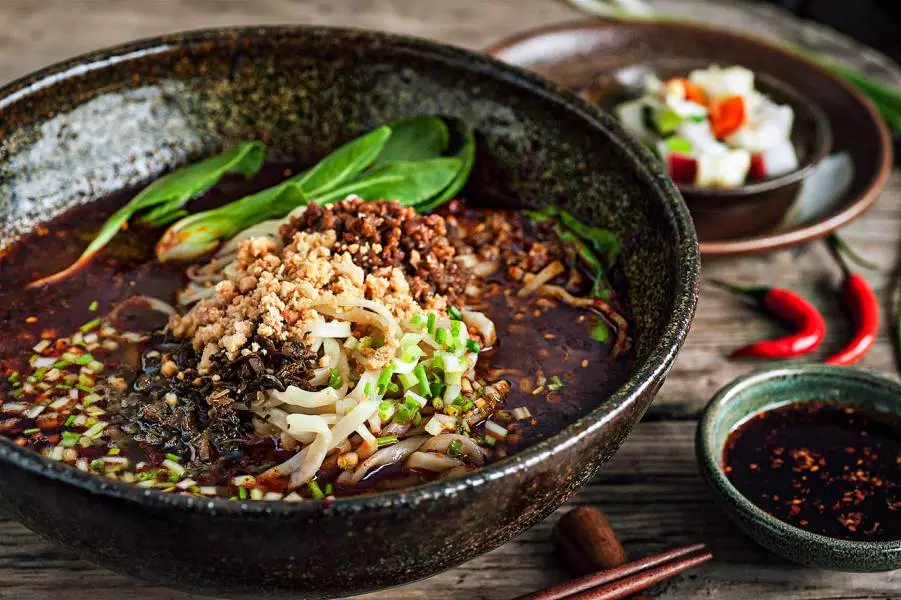
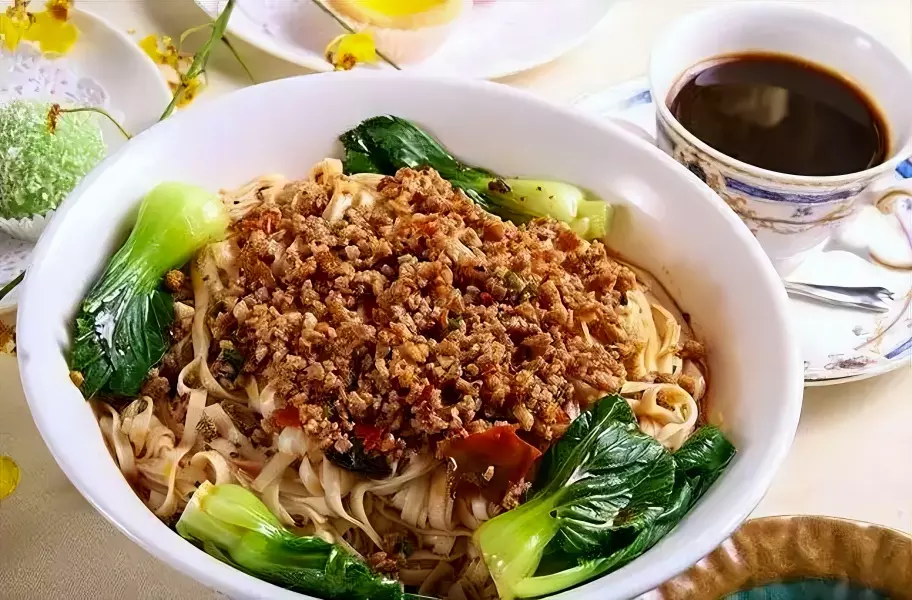
Choosing the Right Noodles
Traditional Sichuan-style noodles are made with chewy, wheat-based strands that are hearty enough to carry the thick sauce. The texture of the noodles is an important element, as they absorb the sauce’s flavors while maintaining a pleasing chewiness. While wheat noodles are ideal, variations with egg noodles or even thin ramen noodles can also work, though authentic recipes rely on the texture and taste of wheat noodles to capture the true essence of Sichuan cuisine.
How to Prepare at Home
Making Dan Dan Noodles at home can be straightforward, but a few specialty ingredients are essential to capture their authentic flavor. Ingredients like Sichuan peppercorns, douchi (fermented black beans), and chili oil are available in most Asian markets or online. To prepare, first cook the noodles according to package instructions. In a separate pan, brown the minced pork with garlic, ginger, and Sichuan peppercorns. Then, make the spicy sauce by combining chili oil, soy sauce, sesame paste, and other seasonings. Toss the noodles in the sauce, and top with the cooked pork for a delicious, flavor-packed meal.
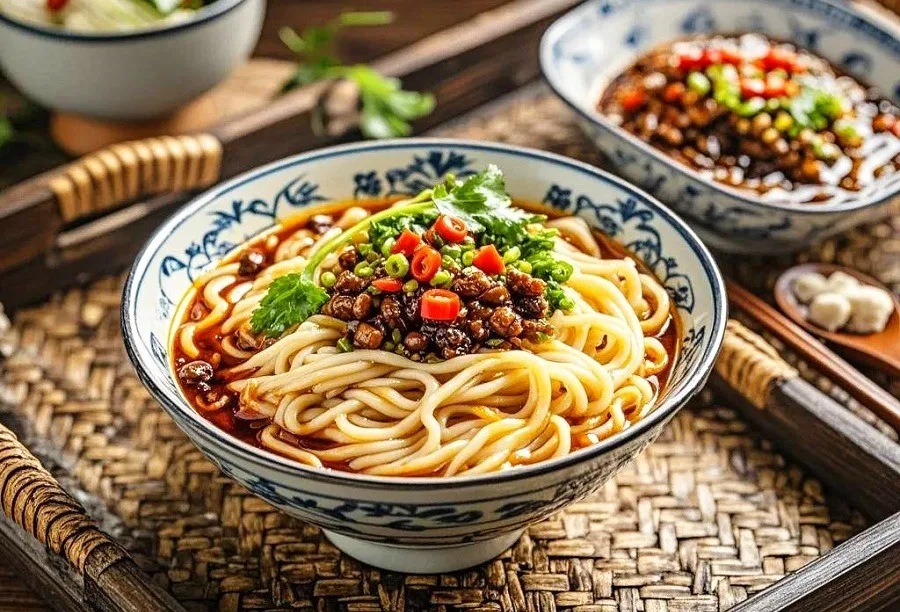
Toppings and Garnishes for Extra Flavor
Classic Dan Dan Noodles are often garnished with chopped green onions, crushed peanuts, or sesame seeds, which add a fresh, crunchy contrast to the spiciness of the sauce. Some variations include pickled mustard greens (ya cai) for a slightly tangy element that complements the bold flavors of the dish. A splash of black vinegar can also enhance the flavor, adding a hint of sourness to balance the heat and umami of the sauce.
Vegetarian Variations and Modern Adaptations
Dan Dan Noodles can easily be adapted to suit vegetarian or vegan diets by substituting the minced pork with tofu or mushrooms. Crumbled tofu or finely chopped mushrooms absorb the sauce and replicate the dish’s rich, savory flavor. The vegetarian version of this iconic Sichuan dish retains the signature numbing-spicy taste and satisfies those who appreciate its versatility.
Why Are Dan Dan Noodles So Popular?
This iconic Sichuan dish represents the essence of the region’s cuisine, where spicy, numbing, and umami flavors come together in perfect harmony. Its global popularity reflects the appeal of a meal that combines depth of flavor, intriguing textures, and a cultural story that continues to attract food lovers worldwide. From street food origins to high-end restaurant adaptations, it remains a beloved choice that embodies both tradition and modern culinary trends.
With its distinctive flavor, versatility, and rich history, this dish is truly a must-try for any lover of authentic Chinese cuisine.
Dan Dan noodles (Dandan Mian 担担面)
Ingredients
Frosting
- 150 g minced pork or beef
- 2 teaspoons soy sauce
- 2 teaspoons Shaoxing rice wine
- 2 tablespoons oil
- 2 tablespoons peanuts coarsely crushed
- 1 teaspoon finely chopped ginger
- 1 tablespoon ground Ya Cai – or Zha Cai
- 1 tsp chilli flakes to taste
Sauce
- 1½ tbsp Chinese sesame paste
- 1½ tsp water
- 2 garlic cloves finely chopped
- 2 tbsp soy sauce
- 1 tbsp black rice vinegar
- 1 teaspoon ground Sichuan peppercorns
- tablespoon chilli oil
- 1 pinch of sugar
Noodles
- 2 servings of noodles – fresh or dried
- 1 handful of leafy green vegetables – e.g. bok choy sum choy spinach etc.
For garnish
- 2 spring onions finely chopped
Instructions
Pork
- Put the minced pork in a bowl. Add soy sauce and rice wine. Mix well to loosen the meat as much as possible.
Topping
- Pour the oil into a cold wok. Add the peanuts and fry over low heat until golden. Transfer the peanuts to a bowl (leaving the oil in) and set aside.
- Add chopped ginger, meat, ground Ya Cai and chili flakes to the remaining oil. When the meat is completely cooked, set aside.
Sauce
- In a bowl, mix the sesame paste and water until semi-liquid and smooth.
- Add garlic, soy sauce, black vinegar, ground Sichuan pepper, chili oil and sugar. Mix well and set aside.
Noodles
- Bring a large pot of water to a full boil. Cook the noodles according to the instructions on the package. Add the vegetables.
- Once cooked, drain and rinse under cold water for a few seconds to remove excess starch.
Serving
- Pour the sauce into two serving bowls. Add the noodles and vegetables.
- Top with cooked meat and peanuts. Garnish with spring onions.

